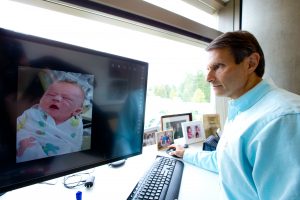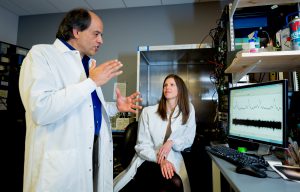
John Kahan manages a team of renowned Microsoft data scientists who are changing how society can use data effectively, from deciding when to plant crops to creating predictive business models.
But when he’s not at work, Kahan commits his time to a personal mission: Raising awareness about Sudden Infant Death Syndrome (SIDS) and fundraising for research. John and Heather Kahan lost their baby boy, Aaron, to SIDS shortly after his birth 13 years ago.
When Kahan’s data science team learned about Aaron, they volunteered to apply Microsoft technology to SIDS data and donate the company’s emerging tech tools to Seattle Children’s researchers who study SIDS.
“My goal is to prevent other families from ever experiencing the devastation of losing a baby to SIDS,” Kahan said. “Our team is delighted to donate this technology to Seattle Children’s scientists who are working to solve this medical mystery.”
A healthy pregnancy and devastating loss
There are a few photos of a healthy, bundled up baby Aaron in his first hours surrounded by his glowing parents and three older sisters. But eight hours after he was born, Aaron stopped breathing in his sleep and died. Doctors could not identify a reason this seemingly healthy baby had died, and it was considered SIDS.
“I had to do something about this,” Kahan said. “I feel incredibly hopeful about the research at Seattle Children’s and we work hard to raise money that can propel the work.”
Along with other families whose babies died from SIDS and additional supporters, Kahan became a dedicated member of the SIDS Research Guild at Seattle Children’s, which raises money for SIDS research. Kahan has been an advocate for Dr. Daniel Rubens’ SIDS research in particular; and began the SIDS Research Fellow Fund. Rubens is a pediatric anesthesiologist at Seattle Children’s Research Institute who’s studying a potential link between SIDS and inner ear damage in newborn babies.
Medical research meets leading edge data science

On a summer day in 2013, Juan M. Lavista, a Microsoft data scientist, walked into Kahan’s office to discuss a project. He noticed a picture of Aaron on Kahan’s desk and asked about it.
“His family’s story shook me because my wife and I were expecting our first baby,” Lavista said. “I went back to my teammates and we began to think about ways we could help.”
When Kahan returned from a trip to climb Mount Kilimanjaro in summer 2016 to honor Aaron and raise money for SIDS research, his team unveiled its plan to use machine learning on Microsoft Azure, a powerful cloud computing platform, and Power BI, a visual information display program.
“I was touched when my team proposed to use these tools to study SIDS,” Kahan said. “It was a total surprise, and they did all this work on a volunteer basis and on their own time.”
The team members took SIDS data from the Centers for Disease Control and Prevention, and performed statistical analysis then fed the results into the Microsoft visualization programs. They wanted to identify risk factors that could increase a baby’s risk for SIDS.
The team knew the tools were working because they independently identified known risk factors, including higher rates of SIDS in babies whose mothers smoke. The team brought in Rubens and his research collaborator, Dr. Nino Ramirez, director of the Center for Integrative Brain Research at Seattle Children’s Research Institute, to look at the models, results and tools.
“I was amazed by how powerful these tools are,” Ramirez said. “These tools and the cutting-edge data science performed at Microsoft will inspire new lines of inquiry for SIDS as we examine potential new associations. Indeed, in an era of big data, this approach will be a gold mine not only for understanding SIDS but also for other avenues for medical research.”
Rubens agrees and has invited SIDS research collaborators in Denmark and London to see how these tools could help researchers to identify trends.
“These tools can help us analyze epidemiological data in ways that were not available before, and to ask questions and put pieces together in a way that wasn’t possible previously,” he said.
Giving medical researchers access to tools and data
Kahan’s team has donated hundreds of hours of volunteer time (which Microsoft matched at $25 per hour) to SIDS Research Guild and shared the models and the system it developed with Seattle Children’s SIDS researchers. Microsoft Philanthropies has donated Azure cloud services for the next two years so they can continue to investigate risk factors.
The researchers plan to input additional data into the system in an attempt to identify new correlations.
“This partnership gives hope to parents like me and many others who have been impacted by SIDS,” Kahan says. “I hope that after hearing my story, more people will contribute to this important cause.”
The Microsoft data science team that spearheaded the SIDS research included Urszula Chajewska, Juan Lavista Ferres, Sushama Murthy, John Kahan, Kelty Allen, Avleen Bijral, Amit Misra, Shirley Ren, John Albanese, Austin Gross, Shweta Mittal, Vincent Chan, Rutger van Haasteren, Richard Johnston, David Levitan and An Luong.
Contributions to SIDS research at Seattle Children’s may be made to the SIDS Research Fellow Fund. The Kahans are matching gifts made to this cause, up to $50,000. Their pledged gift will be matched with another $50,000 by the Jack R. MacDonald Research Fund at Seattle Children’s.
Resources
- SIDS Research Fellow Fund
- SIDS Research Guild
- Doctor Partners on SIDS Newborn Hearing Study to Investigate Link to Inner Ear Damage – Seattle Children’s On the Pulse

